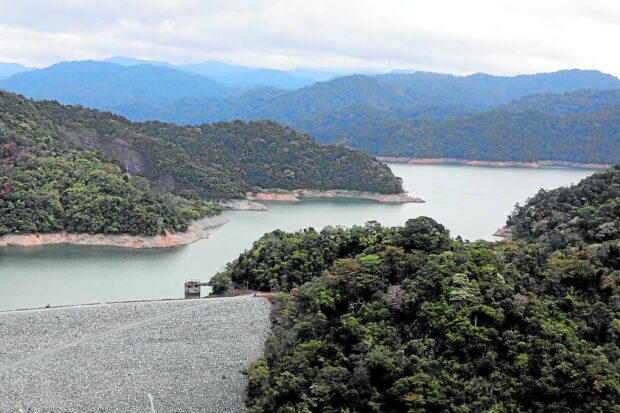
MAJOR SOURCE Farmers in communities near Angat Dam in Bulacan, shown in this undated photo, can expect uninterrupted irrigation supply as promised by officials managing this main source of water for Metro Manila despite the reservoir’s decreasing water level. —PHOTO COURTESY OF NORZAGARAY MDRRMO
CITY OF MALOLOS—The water elevation in Angat Dam in Bulacan province continued to drop but supply for farmers’ irrigation remained sufficient, local officials said on Tuesday.
Data from the Bulacan Provincial Disaster Risk Reduction and Management Office (PDRRMO) showed that the dam’s level has been consistently decreasing by about a meter every week since last month due to the lack of rainfall in the area.
As of Wednesday, the reservoir’s water stood at 209.97 meters above sea level (masl), lower than the 210.08 masl recorded the previous day. The spilling level of the dam is 212 masl.
Although the dam reached its high normal water elevation at 212.11 masl on Jan. 24, no water release was made due to the El Niño phenomenon and the dry season, as confirmed by officials managing the reservoir.
Adequate
On Jan. 14, the dam’s volume was even higher at 213.07 masl, and it peaked at 214.02 masl on Jan. 4, surpassing the normal high water elevation by two meters. The current elevation is 29.97 m higher than its low level of 180 masl.
Gloria Carrillo, Bulacan provincial agriculture officer, assured that farmers in Bulacan have adequate water allocation from the National Irrigation Administration (NIA) until the end of the second cropping season in May.
In a phone interview on Tuesday, Carlos Dimaapi, president of the Farm Irrigators’ Association in Plaridel town, welcomed the assurance from the NIA that there would be no water cut-off until their harvest period at the end of April and the first two weeks of May. The second cropping season began in January.
SHALLOW This photo taken on July 10, 2023, shows the dwindling water level in Angat Dam, enabling residents of Norzagaray, Bulacan, to dock their small boats in sections of
the reservoir that used to be submerged in dam water. That day’s water elevation was 179.23 meters above sea level (masl),
way below its spilling level of 212 masl. —LYN RILLON
El Niño
Dimaapi said the NIA could still gradually decrease the irrigation supply without impacting their crops, noting that Angat Dam’s water level was still within normal range.
He recalled that there was a reduction in water supply in January last year and in 2022 due to mild El Niño conditions.
While a severe El Niño was projected to start in the last quarter of 2023, continuous rains during that period raised the dam level to 214 masl.
The severe El Niño is expected to last until the second quarter this year.
During dry spell months, particularly from January to April, water discharge for farmers’ irrigation needs would usually be halted to prioritize water supply for Metro Manila, which relies on the reservoir for 97 percent of the water requirements of its households and businesses.
READ: Angat Dam now below minimum operating level
In an interview, Ildefonso Canquin, president of a farmers’ group in Bulakan town, said they were thankful for the abundant rainfall in the latter part of 2023, resulting in continuous cropping and good harvests.
Over 27,000 hectares of rice farms, tended by more than 22,000 farmers across 16 towns in Bulacan and in towns in nearby Pampanga province, benefit from Angat’s irrigation water.
The release of water to the NIA is based on the approval of the National Water Regulatory Board, prioritizing the domestic needs of Metro Manila.